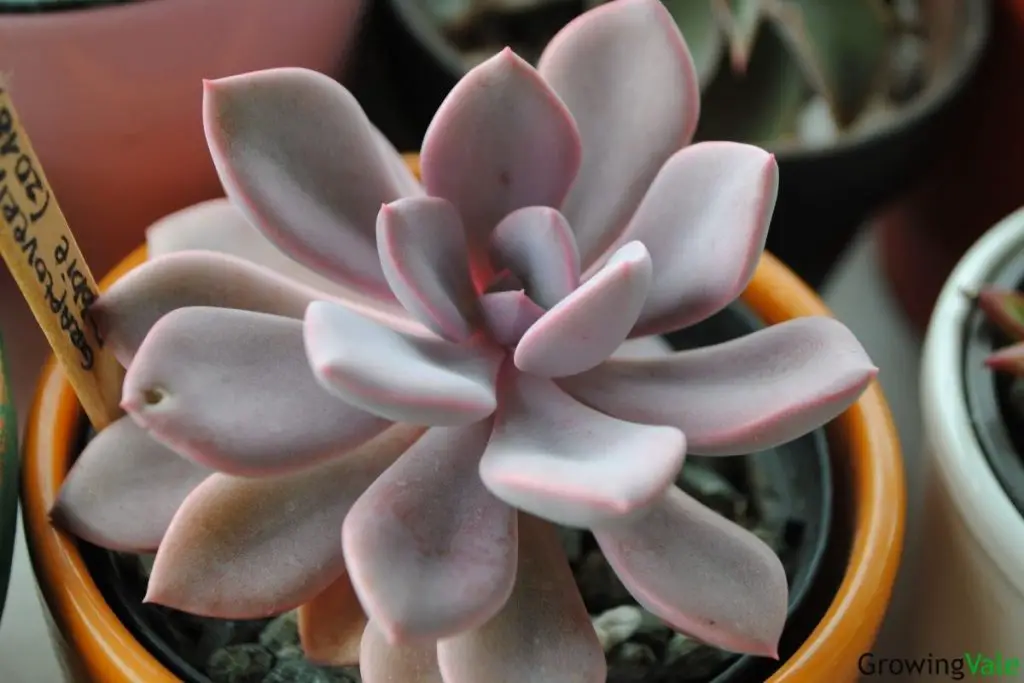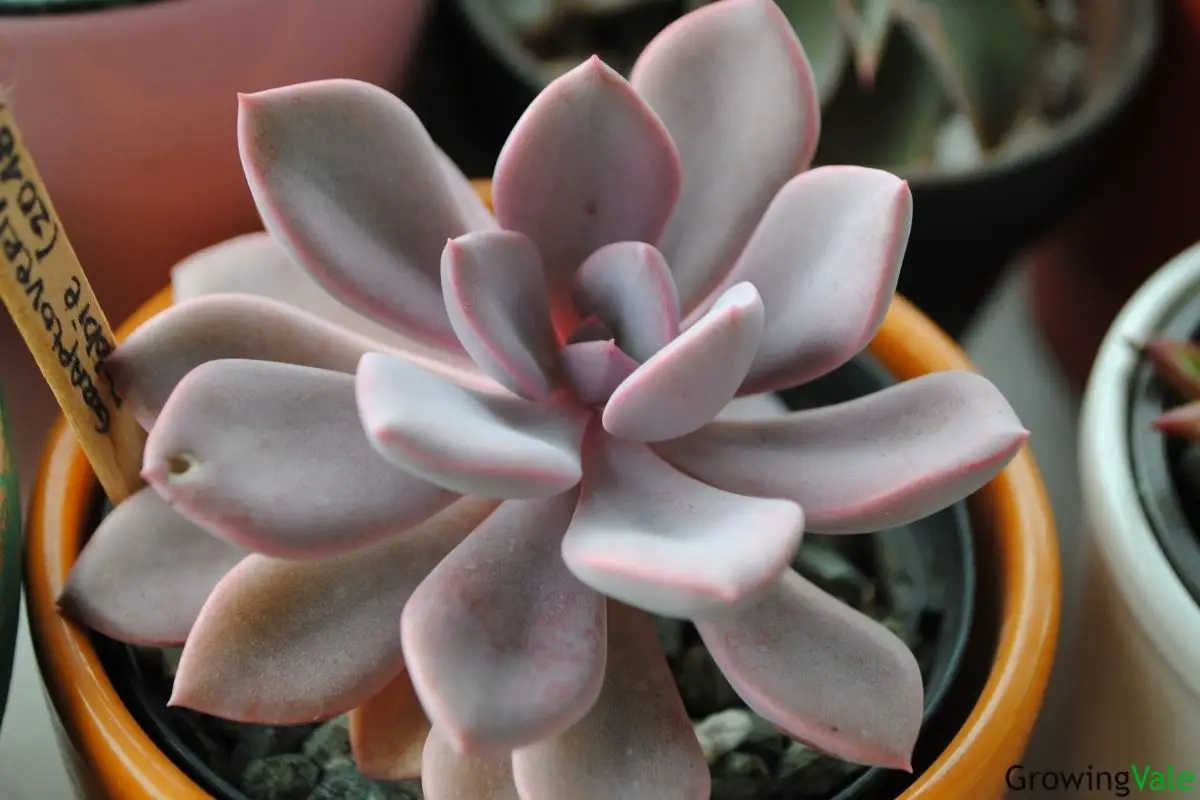Prized by many succulent collectors for its attractive pink or lavender foliage, Graptoveria ‘Debbie’ is an absolute must-have in even the most modest of gardens. Its warm pastel hues complement the bright green and purple shades of most rosette succulents and cacti. It is guaranteed to stand out even through winter, when its colors can deepen as temperatures drop.
Graptoveria ‘Debbie’ is a low-growing cultivar that is relatively easy to care for, though it can take a few years to reach maturity. Its delicate lanceolate leaves resemble paddles, but are plump and slightly pointed.
They are more narrow at the base and are wide enough towards the tips to mask the leaves below. When exposed to optimal conditions, the rosettes are compact enough to hide a slim yet sturdy shoot, which is usually the same color as the leaves.
This perennial succulent is best grown outdoors, where it can receive ample sunlight. When sun-stressed and moisture-deprived, the rosette can become a deeper shade of mauve or old rose, with brown undertones. At maturity, this hybrid grows to around 8 inches tall and can have an equal spread. At this stage of growth, it tends to produce tall bloom stalks with orange or apricot star-shaped flowers.
History
Graptoveria ‘Debbie’ is a product of hybridization between an unknown Echeveria species and Graptopetalum amethystinum. Its colors are remarkably similar to the latter, but its leaves are slightly wider and flatter in comparison. This cultivar is supposedly named after ‘Debbi Foster’, daughter of American horticulturist Robert ‘Bob’ Foster. It is said to have occurred spontaneously in Abbey Garden, a plant nursery in Reseda, California.
Like that of many other rosette succulents, the foliage of Graptoveria ‘Debbie’ is covered in a thin layer of farina (epicuticular wax). This hydrophobic substance helps protect the plant from excess moisture and grazing. Once this wax is touched or scraped off, the leaves are unable to replace the protective covering. This layer can give the pink leaves a whitish appearance.
‘Debbie’ will thrive best in warm, dry climates. Its rosettes tend to be more sensitive to humidity, especially when the oldest leaves come into contact with the soil. Due to its low-growing habit, ventilation is an absolute must to ensure that the substrate thoroughly dries. If its needs are met, you can be certain this plant will reward you with a wealth of offsets that will eventually crowd out a pot.
Plant Facts
| Scientific name | Graptoveria ‘Debbie’ or ‘Debbi’ |
| Common names | Graptoveria ‘Debbi’, x Graptoveria ‘Debbie’ |
| Genus | Graptoveria |
| Family | Crassulaceae |
| Height | 8 inches |
| Width | 8 inches |
| USDA Plant Hardiness Zone | 9-11 |
| Origin | Chance Hybrid (California) |
| Flower colors | Orange, Apricot |
| Blooming season | Spring |
| Plant/Flower special features | Star-shaped flowers, Lanceolate Pink Leaves |

How to Plant and Grow Graptoveria ‘Debbie’
Graptoveria ‘Debbie’ should be planted in terracotta pots or containers that promote proper drainage. A short, porous pot would work best to ensure that the soil does not retain moisture for too long. You can plant multiple rosettes into one wide pot to create a pink cluster of plump leaves.
Graptoveria plants can be grown via seed, but this mode of planting is quite challenging as germination times can vary from a few days to a few months. Depending on your ambient conditions, the seeds can struggle to shift out of dormancy or access consistent moisture to generate tissue production. Beginner gardeners are better off making use of mature plant parts to grow their collection.
How to Propagate Graptoveria ‘Debbie’
Propagate this Graptoveria hybrid via leaves, stem cuttings, or offsets. Make sure to use mature, healthy plant parts to ensure that nutrient stores are provided for new growths. If you intend to make use of leaves, remove the oldest one first as these should easily come off of the stem. Gently wiggle them off of the mother plant and allow any exposed parts to scab over completely prior to placing them over a thin layer of soil.
Branches can be propagated and treated as individual rosettes. To remove these from the mother plant, make use of sterilized gardening shears or sharp scissors. Create as clean a cut as possible so that exposed parts can callous over neatly and quickly. Store cut branches and stems in a dry area and allow these to develop new roots before planting them.
Graptoveria ‘Debbie’ offsets are best removed by uprooting the entire mother plant. These will usually have their own set of young roots, so carefully separate them to keep the root systems intact. Offsets that are cleanly separated (no exposed tissues) can be planted directly into soil. Those with wounds should be allowed to dry and scab over before planting as usual.

Care and Maintenance
Soil
Use a store-bought potting mix specially made for cacti and succulents and fill a pot with a water hole at the bottom. To prevent the soil from streaming out of the pot, the hole can be covered with stones, a wire mesh, or a thin layer of coconut coir.
You can also create your own well-draining mix with sand, gravel, sterilized compost, and porous stones (such as pumice or perlite). Avoid covering the topsoil with toppings as these can trap excess moisture and stimulate the growth of fungi and bacteria.
Water
Water the soil only when it has dried out completely or if the top few inches are dry. You can use a moisture meter or stick your finger into the soil to gauge its dryness. You can also make use of a wooden chopstick or skewer; if the soil is dark and sticks to the wood, its moisture content is still high.
When watering your Graptoveria ‘Debbie’ outdoors, water the soil thoroughly enough so that moisture reaches the bottom of the pot. Ideally, water should stream out of the pot’s bottom hole. If watering your plant indoors, make sure that any excess water in the catch plate is disposed of right away. Place your plant in a well-ventilated area to prevent moisture-related diseases.
Fertilizer
Graptoveria ‘Debbie’ does not require fertilizer as it can thrive in poor soil conditions. The draining capacity of the soil is more important than its nutrient content.
You may opt to provide a very small amount of fertilizer for mature plants if they are unable to produce flowers. At most, make use of just a third of the recommended concentrations to prevent your succulent’s roots from burning.
Sunlight
Place your Graptoveria ‘Debbie’ rosettes in an area that receives a few hours of full sun. Partial sun exposure or filtered sunlight is acceptable, though the plant’s foliage may not display the characteristic lilac-pink color of this hybrid. If located in an area with intense summer conditions, move your pot to a partly shaded area. If this isn’t possible, use a shade cloth to prevent the leaves from getting scorched.
Temperature and Humidity
Most Graptoveria cultivars are not known for being cold hardy succulents, and ‘Debbie’ is no exception. It can withstand high temperature and drought conditions outdoors, but must be moved inside your greenhouse or home as soon as temperatures drop considerably. The leaves of this plant are highly sensitive to frosts and would benefit from a warm, windowside location through winter.
When indoors, water your Graptoveria ‘Debbie’ sparingly to prevent moisture-related diseases from occurring. This hybrid can withstand low humidity conditions, but must be exposed to ventilation if humidity in your area is high. You can make use of a fan or an indoor dehumidifier to trap excess moisture in the air.
Pruning
Low-growing rosettes don’t necessarily need to be pruned. They should only be cut down in cases where they produce heavy branches, have diseased young leaves, or don’t grow upright.
If your Graptoveria ‘Debbie’ becomes leggy due to low sunlight or excess water, you can behead your succulent and replant the upper, more compact section of the rosette. The lower leaves and shoot may be propagated (i.e., the leftover shoot can be allowed to produce new young plants).
Repotting and Transplanting
When clusters of Graptoveria ‘Debbie’ become too crowded or if a single rosette outgrows its pot, you should consider repotting your plant. Clusters with multiple offsets should be divided prior to being repotted so that the roots can be re-oriented. If planting your offsets into one pot, give each one ample space to spread its roots in the soil.
If repotting a single rosette, select a pot that is around 1-2 inches longer than its root system and at least an inch wider than its width. This will allow your succulent to slowly grow into its larger pot without risking excessive moisture due to a surplus of soil.
Pest and diseases
In optimal growth conditions, Graptoveria ‘Debbie’ is resistant to many common pests and diseases. It is highly sensitive to overwatering and humidity, however, as these tend to stimulate the growth of fungal colonies and attract many pests.
To prevent pest infestations, isolate any affected succulents and manually remove pests as soon as you spot them. Treat your plant with a detergent solution or with an organic pesticide mix. In the case of serious diseases, such as root rot or widespread fungal colonies, you may have to uproot your plant and remove all infected tissues. Healthy tissues can be propagated to generate new plants.
Uses of Graptoveria ‘Debbie’
This rosette succulent would be a perfect addition to container gardens, ornamental succulent arrangements, and bouquets. Its pleasant pastel colors are eye-catching and quite unique in the plant world, making it a potential conversation piece and focal feature. If located in an area that experiences dry climate conditions, you can grow colonies of this hybrid alongside other low-growing rosettes to create a live garden mosaic.
Common Varieties
There are many Graptoveria types, but if you’re lucky, you may one day come across Graptoveria ‘Debbie’ Variegata, which is the variegated form of this hybrid. This amazing cultivar produces marbled leaves with subtle light streaks. Its variegation is accentuated under full sun exposure. The leaves displaying the most distinct variegated appearance can be propagated to produce more variegated rosettes.
A remarkable crested variety also exists and is aptly called Graptoveria ‘Debbie Crest’ or ‘Debbie’ var Cristata. This non-rosette variety produces leaves that are slightly more blue or green in color, though pink edges appear under full sun. The pointed leaves grow profusely around a non-distinct shoot. For this reason, this crested succulent can often look like a clump of leaves with no single orientation.
Leaf propagation of ‘Debbie’ leaves can sometimes naturally result in these interesting varieties. Regularly select for variegated or mature Cristata leaves to develop colonies of these forms.
Conclusion
Graptoveria ‘Debbie’ would undoubtedly be an eye-catching addition to your succulent garden. With its delicate leaves and attractive colors, any gardener would be tempted to cultivate colonies of this plant. It is relatively undemanding in terms of water and nutrient requirements, so even plant enthusiasts with a busy schedule can easily care for this succulent.
Do bear in mind that this cultivar is remarkably similar to another one – Graptoveria ‘Spirit of ‘76’. Make sure to check for the appropriate name when searching for this succulent in your local plant nursery or via online portals.
*References
Reference list:
Glass, C. & Foster, R., X Graptoveria ‘Debbi’ [New cultivar],
https://agris.fao.org/agris-search/search.do?recordID=US19780319740
Wrinkle, G., Bob Foster (1938-2002),
https://plants.jstor.org/stable/10.5555/al.ap.person.bm000138738
Koch, Kerstin & Barthlott, Wilhelm, Plant Epicuticular Waxes: Chemistry, Form, Self-Assembly and Function,
https://journals.sagepub.com/doi/pdf/10.1177/1934578X0600101123
”Close”

